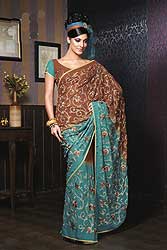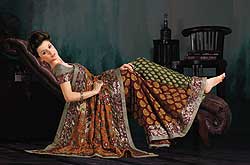|
 Attending a Parsi wedding or navjote (initiation) ceremony of the old Zoroastrian community of Bombay is a quintessential Mumbai experience. Held in “baugs” -- Parsi colonies -- around the city, the ceremonies take place in the attached fire temples after which the community and their friends spill out into the adjoining area to party on in an amalgam of Western and Eastern custom. Attending a Parsi wedding or navjote (initiation) ceremony of the old Zoroastrian community of Bombay is a quintessential Mumbai experience. Held in “baugs” -- Parsi colonies -- around the city, the ceremonies take place in the attached fire temples after which the community and their friends spill out into the adjoining area to party on in an amalgam of Western and Eastern custom.
A sit-down dinner consists of a traditional meal off banana leaves, while a bar serves alcohol and ribald jokes fly. Ladies come out in their finely embroidered garas and blinding old Cartier jewelery and swing to Sinatra being played by a live band.
Haute couture: The house of Parsi
The Alpaiwala museum, inside Khareghat colony just around Kemps Corner in Mumbai. Off Hughes Road a little further down from Kemps Corner and inside Khareghat colony is the Alpaiwala museum, housing all things Parsi. It is an interesting browse for those unfamiliar with traditional Parsi artifacts. Often touted as the only “community” museum in Mumbai, Nivedita Mehta, the curator, is at hand to tell you the history of each piece. Among the more grand and historical exhibits collected by Framji Dadabhoy Alpaiwalla and Jamshed Unwala, are a pair of elegantly embroidered shoes made to match a similarly embroidered sari.
This tradition of wearing cloth shoes died out, but those matching gorgeous hand embroidered gara saris are still worn as a symbol of the community. The gara may have found its way to high-end boutiques today on demand from other communities but it is essentially a Parsi construct.
|

THE LEGACY OF SCINTILLATING PARSI SARIS |
The Parsi community was the first to co-opt Western customs and they extended this to the traditional sari. So six metres of silk from China (“gaaj” or “paaj”) came back with traditional Chinese embroidery on the border |
The Parsi community was the first to co-opt Western customs and dress and they extended this to the traditional sari. So six metres of silk from China ("gaaj” or “paaj") came back with traditional Chinese embroidery on the border and the decorative end of the sari known as the “pallav” or the entire body of the sari. And the gara was born.
Initially the entire length of cloth had a border embroidered, it was “framed", as was said. Then as the fashionable women disapproved of the thick bulge at the waist where the sari was tucked in, the newer ones left the top length of the sari unembroidered. The style of wearing the sari by the Parsi women also gave the really old saris a distinctive mark. The corner of the pallav was left unembroidered as this bit was tucked in at the waist when worn in the Gujarati style as Parsi women of yore were wont to do.
Trading borders: Opium and saris
Gara embroidered motifs are strongly Chinese: birds, flowers and even pagodas.When the Sassoons and Jeejeebhoys, wealthy Jewish and Parsi traders of the 19th century, started trading in opium and yarn with China, the gara border was one of the many side-effects. You'll find the motifs are strongly Chinese: birds, flowers and even pagodas. The tradesmen made a brisk profit from these highly prized, superbly embroidered saris selling, them into affluent Parsi homes. These have been handed down through generations as heirlooms. And heirlooms they are.
With the Chinese political upheavals of the 20th century this trade stopped and has all but vanished. There is a revival today but the embroideries done here cannot match the intricate design, fineness of execution or subtlety of the colors of the old Chinese-embroidered garas. The price of these has escalated and most of the saris are disintegrating with the ravages of time and weather.
While borders or “kors” are easy to come by, as are fragments of embroidery, a whole sari, embroidered in exquisitely placed French knots and an intact border could set you back by hundreds of thousands of rupees. Other collectibles as offshoots of the gara were jhablas or tunics and badans or bodices, both embroidered in similar fashion and often seen framed in Parsi homes today.
Where to find this rare thing
A book, “Peony and Pagodas Embroidered Parsi Textiles,” has recently been brought out by the Tapi collection. The Tapi textile collection is the dedicated passion that Shilpa and Praful Shah have for collecting old Indian textiles. Their mills in Surat may roll out modern fabric but their passion for old textile has resulted in probably the foremost private collection of historic textiles from India. It has exquisite and rare examples of the Parsi gara saris and the book is a must-own for any true sari lover. (There's also “Saris: Tradition and Beyond” by Roli Books)
At the Ratan Tata Institute at Babulnath, a band of ladies used to handling these saris will advise you on how to look after them, launder them for you, attach an old border on a new length of silk, and “aahh” with you over something truly treasurable with the same depth of feeling you have. I have had old borders come back to life thanks to them working assiduously (and trust me, they will not be rushed) and then worn them to much all round appreciation.
You may not be a Parsi but you could still own a gara. Trawl the old second-hand sari shops off Grant Road, splurge at a boutique stocking new ones or on one of Naju Davar's new revivals, or just buy a border and give it a new lease of life.
|